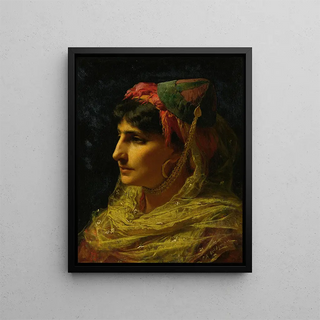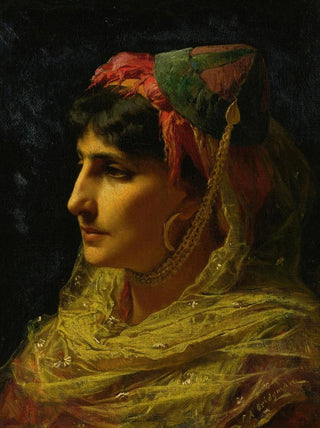Painting Portrait of a Woman - Frederick Arthur Bridgman


View from behind

Frame (optional)
In the fascinating world of art, some works stand out for their ability to capture the very essence of humanity. The "Portrait of a Woman" by Frederick Arthur Bridgman is one of those creations that go beyond the simple frame to immerse the viewer in an intense emotional experience. This piece, imbued with delicacy and sophistication, evokes not only the external beauty of its subject but also a psychological depth that invites contemplation. Through this art print, the charm and grace of this woman are revealed, offering a window into a bygone era while resonating with contemporary emotions.
Style and uniqueness of the work
Bridgman's style is characterized by meticulous attention to detail and a subtle color palette that gives his portraits a unique atmosphere. In "Portrait of a Woman," the artist skillfully plays with light and shadow, creating gentle reflections that accentuate the delicate features of her model. The use of rich textures in the clothing and hair, along with harmonious composition, demonstrates impressive technical mastery. This painting does not merely depict a woman; it tells a story, that of introspection and timeless elegance. The slightly tilted posture and the woman's gaze, both thoughtful and captivating, invite the viewer to ponder her thoughts and emotions. Every brushstroke seems imbued with a life of its own, making this work a true masterpiece of portraiture.
The artist and his influence
Frederick Arthur Bridgman, an American painter of the 19th century, is often recognized for his works evoking oriental and exotic themes, but it is in the realm of portraiture that he demonstrated a particular sensitivity. Influenced by the great masters of painting, Bridgman developed a style that is uniquely his own, blending realism and romanticism. His artistic journey was marked by travels across Europe and the Middle East, where he drew inspiration from the culture and landscapes he encountered. This diversity of influences is reflected in "Portrait of a Woman," where one perceives a fusion of styles that transcends geographical boundaries.

Matte finish

View from behind

Frame (optional)
In the fascinating world of art, some works stand out for their ability to capture the very essence of humanity. The "Portrait of a Woman" by Frederick Arthur Bridgman is one of those creations that go beyond the simple frame to immerse the viewer in an intense emotional experience. This piece, imbued with delicacy and sophistication, evokes not only the external beauty of its subject but also a psychological depth that invites contemplation. Through this art print, the charm and grace of this woman are revealed, offering a window into a bygone era while resonating with contemporary emotions.
Style and uniqueness of the work
Bridgman's style is characterized by meticulous attention to detail and a subtle color palette that gives his portraits a unique atmosphere. In "Portrait of a Woman," the artist skillfully plays with light and shadow, creating gentle reflections that accentuate the delicate features of her model. The use of rich textures in the clothing and hair, along with harmonious composition, demonstrates impressive technical mastery. This painting does not merely depict a woman; it tells a story, that of introspection and timeless elegance. The slightly tilted posture and the woman's gaze, both thoughtful and captivating, invite the viewer to ponder her thoughts and emotions. Every brushstroke seems imbued with a life of its own, making this work a true masterpiece of portraiture.
The artist and his influence
Frederick Arthur Bridgman, an American painter of the 19th century, is often recognized for his works evoking oriental and exotic themes, but it is in the realm of portraiture that he demonstrated a particular sensitivity. Influenced by the great masters of painting, Bridgman developed a style that is uniquely his own, blending realism and romanticism. His artistic journey was marked by travels across Europe and the Middle East, where he drew inspiration from the culture and landscapes he encountered. This diversity of influences is reflected in "Portrait of a Woman," where one perceives a fusion of styles that transcends geographical boundaries.
12,34 €






